Table Of Contents
What Is Trace Precedents Excel?
Trace Precedents in Excel is a powerful tool that allows users to understand the relationships between cells and formulas within a spreadsheet. By using this feature, professionals can trace how a particular cell's value is derived by identifying all the cells that directly or indirectly contribute to its calculation. This functionality enables users to easily troubleshoot complex formulas and identify potential errors or inconsistencies in their calculations.
To use the trace precedent feature and track the cells that contribute to it, follow these steps:
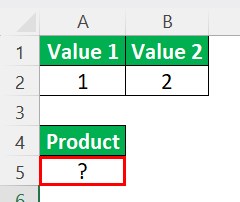
To begin with, enter the formula in cell A5.
So, the complete formula is: =A2*B2.
Now, select the cell that contains the formula. From the Formula Auditing group in the Formula bar, choose the Trace Precedents option. The image below shows a visual representation of arrows that indicate which cells influence the value of the currently selected cell.
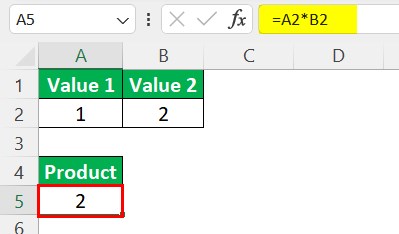
Likewise, we can use trace precedents in Excel.
Table of Contents
- Trace Precedents feature in Excel offers many benefits that aid professionals in analyzing and understanding complex formulas or calculations.
- Excel's Formula Auditing Tools are invaluable built-in features that empower users to trace precedent and dependent cells, evaluate formulas, and perform basic error checking.
- Precedent cells, referenced by other cells in a formula, and dependent cells, which contain their formulas, can be easily identified using these auditing tools.
- Errors can occur when a formula fails to produce a valid result. In such cases, the formula cell will display an error value, alerting users to the issue.
How To Use Trace Precedents Excel? (With Steps)
Follow these steps to use Excel's Trace Precedents feature.
- Firstly, select the cell for which we want to identify its preceding cells.
- Next, go to the Formulas tab on the Excel ribbon and click on Trace Precedents in the Formula Auditing section.
- This will draw arrows from the selected cell to all its preceding cells.
- To further explore precedents, double-click on a precedent cell to have arrows drawn, indicating any cells that feed into it.
- Moreover, we can also access additional options, such as removing arrows or viewing a graphical representation of all precedents using the dropdown arrow next to Trace Precedents.
- This fundamental tool is particularly beneficial when auditing complex formulas or understanding how calculations are performed within our spreadsheets.
By utilizing this feature proficiently, professionals can better grasp the logic and dependencies of their data, thus facilitating efficient error analysis and making informed decisions based on accurate information within Excel workbooks.
Examples
Example #1 - Trace Indirect Precedents
To find the value and trace precedents, follow these steps:
Step 1: To begin with, choose an empty cell as the output. In this case, we will use cell A5.
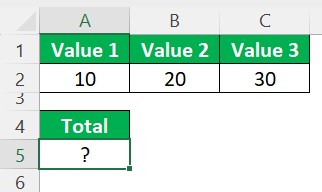
Step 2: Next, begin by entering the formula in cell A5.
Step 3: So, the complete formula is: =A2+B2+C2. After entering each value in the previous step, press the Enter key. The image below displays the result in cell A5, which is '60'.
Step 4: Now, select the cell that contains the formula.
Step 5: From the Formula Auditing group in the Formula bar, select the Trace Precedents.
Step 6: The image below show arrows which cells impact the value of the currently selected cell.
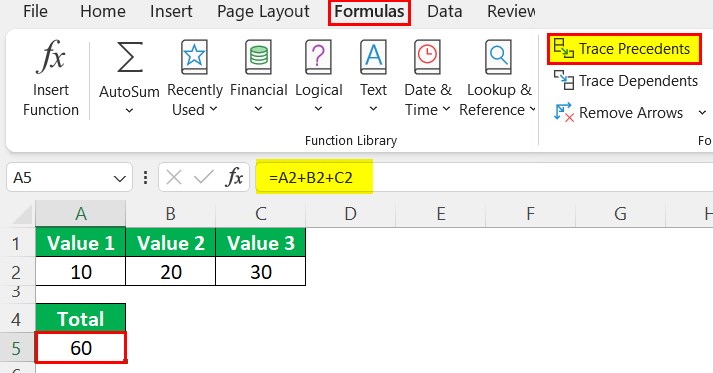
Example #2 - Trace Precedents For Multiple Cells
To find the interest amount and track the preceding Multiple cells, please follow these steps:
Step 1: To start with, choose an empty cell as the output. For this example, we will use cell A5.
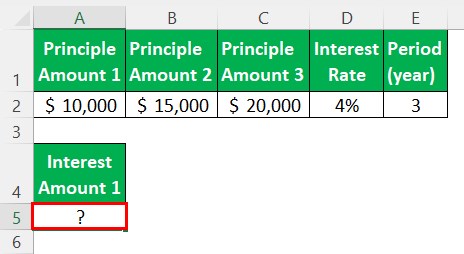
Step 2: Next, begin by entering the formula in cell A5.
Step 3: So, the complete formula is: =B2*D2*E2. After entering each value in the previous step, press the Enter key. The image below showcases the result in cell A5, which amounts to $1800.
Step 4: Now, select the cell that contains the formula.
Step 5: From the Formula Auditing group in the Formula bar, select the Trace Precedents option.
Step 6: The image below provides a visual representation of arrows that shows which cells influence the value of the currently selected cell.
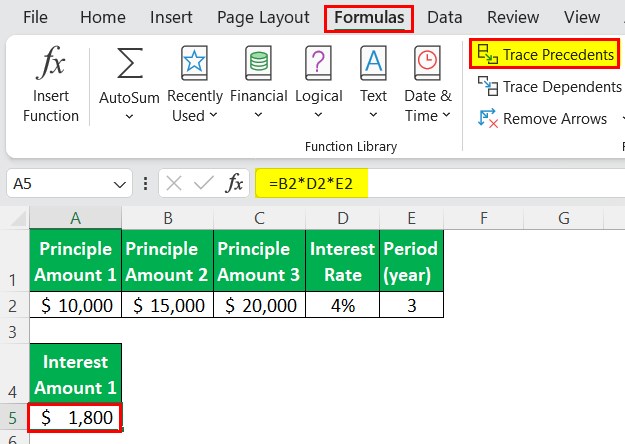
Example #3 - Trace Precedents Referring To Another Worksheet
To find the interest amount and keep track of the cells referring to another worksheet that contributes to it, follow these simple steps:
Step 1: First, choose an empty cell as the output. For this example, let's use cell A2.

Step 2: Next, enter the formula in cell A2 in Sheet 4.
Step 3: The formula is: =(Sheet3! A2 * Sheet3! B2 * Sheet3! C2)/100. After entering each value in the previous step, press the Enter key. The image below shows the result in cell A2, which amounts to $5.
Step 4: Now, select the cell that contains the formula.
Step 5: From the Formula Auditing group in the Formula bar, select the Trace Precedents.
Step 6: The image below provides a visual representation of arrows that indicate which cells influence the value of the currently selected cell.
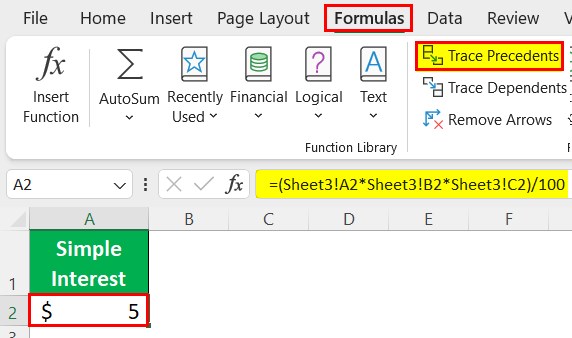
How To Remove Arrows Of Trace Precedents? (With Steps)
- First, open the worksheet that contains the trace precedents arrows we want to remove. Make sure we are in the cell where the arrow originates.
- Next, go to the Formulas tab in the Excel ribbon and click on the Remove Arrows option within the Formula Auditing group of commands.
- A drop-down list will appear with three options: Remove Precedent Arrows, Remove Dependent Arrows, and Remove All Arrows.
- Choose Remove Precedent Arrows to solely eliminate arrows pointing to this specific cell or opt for Remove All Arrows if we wish to delete all precedent and dependent arrows from our entire workbook.
- After selecting our preferred option, click on it to instantly remove all the selected arrows from our worksheet.
Important Things To Note
- The Formula Auditing tool is conveniently located under the Formula tab in a separate group, making it easily accessible for users.
- To display formulas throughout the sheet, simultaneously press the keyboard shortcut "CTRL + `."
- Evaluating formulas is a breeze with the keyboard shortcut "F9," allowing users to analyze their calculations easily.
Frequently Asked Questions (FAQs)
• One primary advantage is its ability to visually track the cells contributing to a particular formula, which promotes transparency and clarity when working on large datasets or intricate spreadsheets.
• By following the arrow lines as indicators, users can easily identify and comprehend the dependencies between various cells, preventing errors and enabling them to troubleshoot formula-related issues promptly.
• Firstly, this feature only works within the workbook where the formula is located. It does not track external references or precedents from other workbooks.
• Secondly, it can become less effective when dealing with nested or branched formulas involving multiple function layers. In these cases, the trace lines can become overcrowded and difficult to interpret accurately.
• Additionally, it should be noted that if a precedent cell uses an array formula or is part of a data table, the trace lines may not appear correctly.
To implement the trace precedent feature,
First, enter the formula in cell A5. So, the complete formula is: =A2*B2.
Next, select the cell that contains the formula. From the Formula Auditing group in the Formula bar, choose the Trace Precedents option. The image below shows arrows that indicate which cells influence the value of the currently selected cell.
Download Template
This article must help understand the Trace Precedents Excel examples. You can download the template here to use it instantly.
Recommended Articles
This has been a guide to What Is Trace Precedents Excel. Here we explain the how to use trace precedents excel and how to remove it along with step by step examples and shortcut. You may learn more from the following articles –
